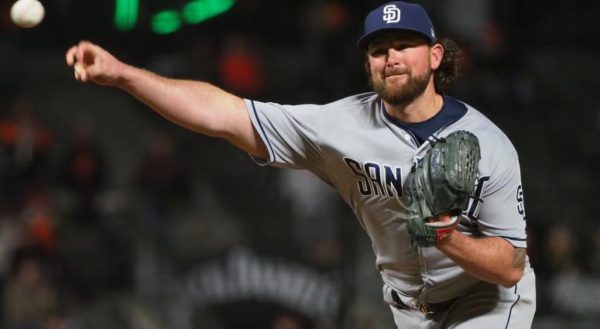Padres’ closers with a history of being clutch, just not in non-save situations

Credit: Getty Images

A look at the history of closers that have played for the San Diego Padres and oddly why they have not performed in non-save situations.
The San Diego Padres have a proud history at the closer position.
The most recent Hall-of-Famer to wear a Padres’ cap is Trevor Hoffman. He, at one point, held the record for most career saves and eventually retired with 601 saves. Hoffman is the pride of San Diego closers, but since his retirement in 2010, the Padres have managed to fill his role with top of the line players. Since 2000, Padre closers have accumulated 13 total All-Star bids (Hoffman 4, Bell 3, Street 2, Rodney 1, Hand 2, Yates 1). With these great numbers, let’s review why the Padres are producing such quality men at the position.
The first pitcher to look at is current Padres closer, Kirby Yates. In 2019, he was an All-Star and named to the All-MLB first team. He earned those awards by pitching for 41 saves and a 1.19 ERA. To isolate the season into the role of a closer instead of a typical reliever (after all closers are just relievers who get saves), we would need to isolate his save situations numbers and his non-save situation numbers.
Yates pitched 45.2 innings pitched in save situations while recording a 0.59 ERA and 0.745 WHIP. Looking at his non-save situation numbers, he pitched 15.0 IP for a 3.00 ERA and 1.33 WHIP. The numbers speak for themselves; when Yates is closing, he dominates, when Yates isn’t closing, he isn’t the same pitcher.
This trend continues for other pitchers across the Padres organization. Look towards Trevor Hoffman’s 1998 season, in which finished 2nd in Cy Young voting, 7th in MVP voting, and finished with a career-high 53 saves. That season that tallied a 1.48 ERA split into 55.2 IP in save situations with a 0.49 ERA and 0.701 WHIP against 17.1 IP with a 4.67 ERA and 1.327 WHIP. Hoffman’s best year is similar to Yates, filthy in save situations and a different pitcher in non-save situations.
Now to find out if this is a trait of closers or just Padres’ closers, its time to explore some of the great closing seasons of the 2000s. The first one to look at is Fernando Rodney’s historic 2012 season with the Tampa Bay Rays. He completed the year with 48 saves, a minuscule 0.60 ERA, and a 0.777 WHIP. Looking at his save situation stats: 47 IP, 0.57 ERA, 0.787 WHIP; non-save situations: 27.2 IP, 0.65 ERA, 0.759 WHIP. Rodney, this year was dominant no matter the situation. While his ERA is weaker in non-save situations, it is still amazing, and he has a better WHIP.
Another case is Craig Kimbrel’s 2013 season with the Atlanta Braves. For the year, he finished with 50 saves, 1.21 ERA, and a 0.881 WHIP. Quickly jumping into his splits when in save situations: 53.1 IP, 1.35 ERA, 0.825 WHIP; in non-save situations: 13.2 IP, 0.66 ERA, 1.098 WHIP. His ERA is actually better in non-save situations while having a worse WHIP. For a closing pitcher, the ERA is critical because their team will have a small lead and need it to be held.
Now that we have compared two great Padre seasons with two great non-Padre seasons. Countless other examples go against this trend, but the numbers do prompt some questions. Do the Padres develop average pitchers, that in save situations, grow a clutch mentality and become dominant pitchers? Or do the Padres have great closers that perform worse when they are not in their typical save situations?
Now there are always variables with looking at the general stats.
First off, in non-save situations, all the pitchers have a lot smaller sample size, so a few bad innings can really skew these numbers. Secondly, most managers will put in the closer for just the 9th inning. If they come in elsewhere, it could be for mid-inning help. The Padres have an advantage playing half their games at Petco Park, which is a friendly pitchers park (Both Rodney and Kimbrel had good seasons when playing for the Padres).
Overall the Padres have had a history of great closers and looking at the young arms in their bullpen currently, that history will continue. Just don’t ask the reliever to pitch in a non-save situation.
Evan is a student finishing up a degree in Finance from Northern Arizona University. The ability to break down numbers and find the story behind them has lead to his first of writing for East Village times. He covers baseball which is the sport he grew up playing and has followed even after his playing years.